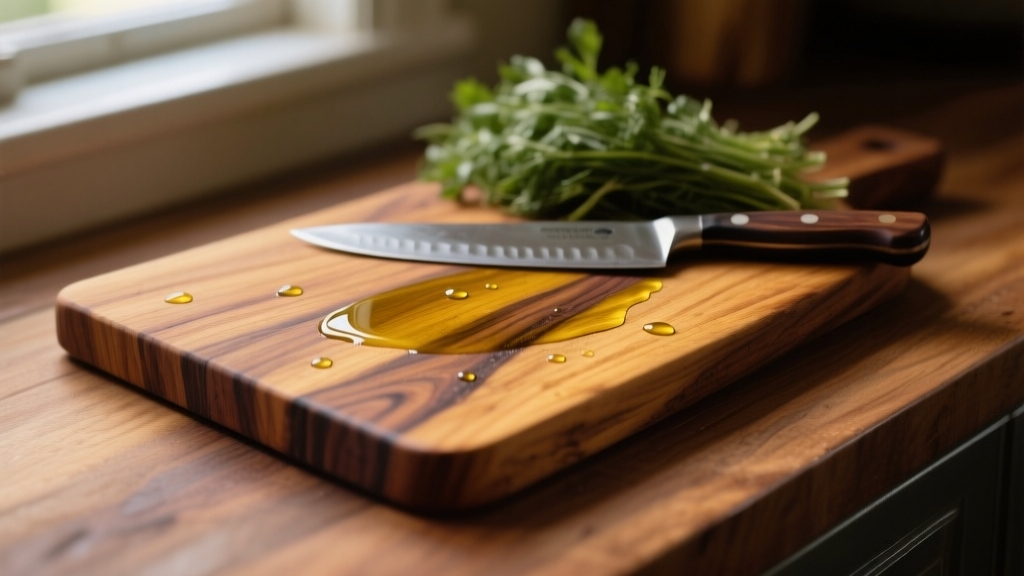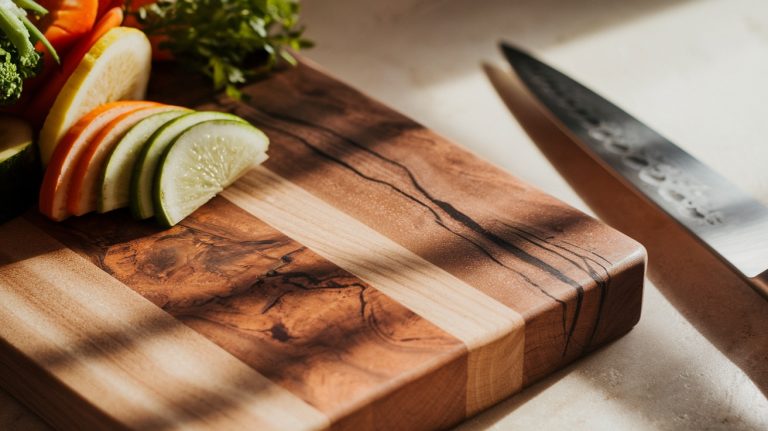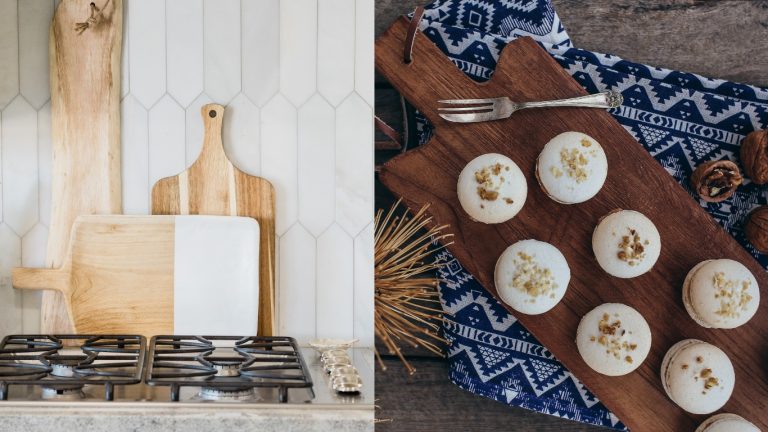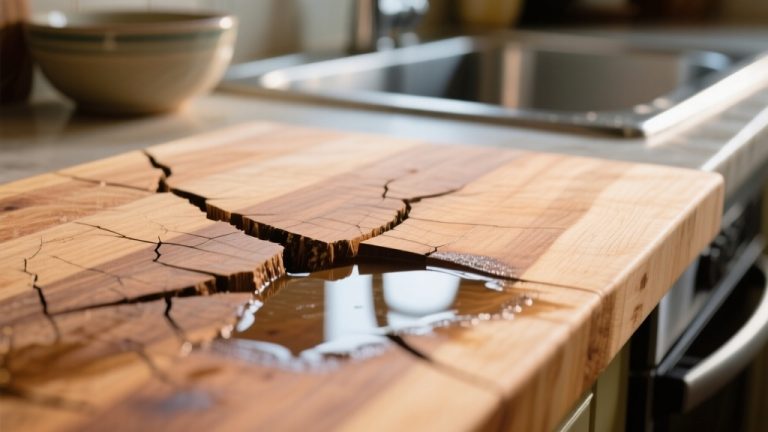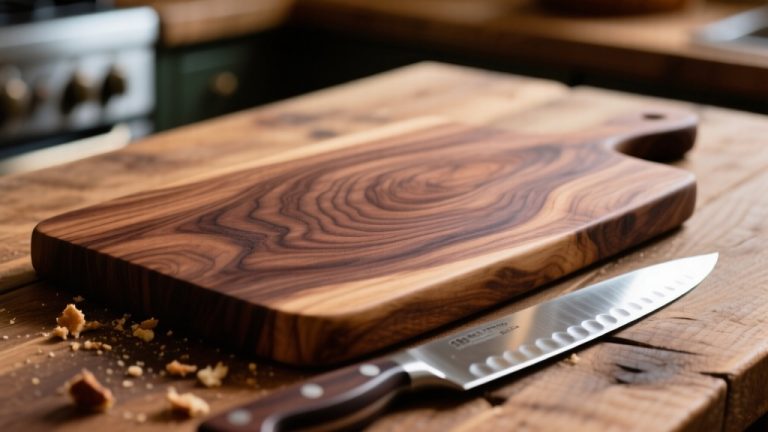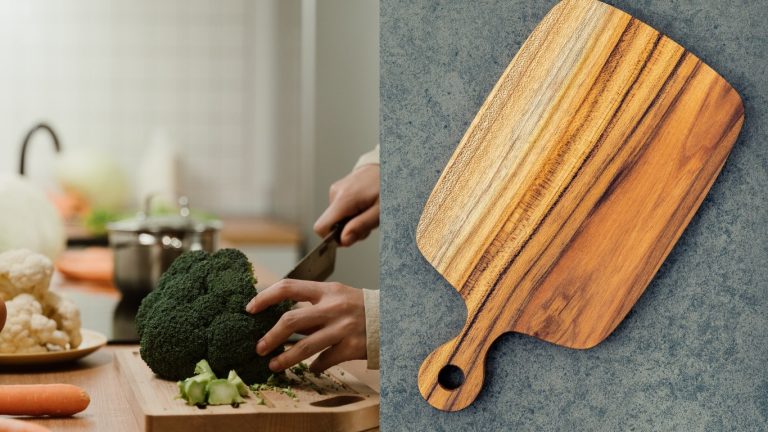Is Teak Wood Good for Cutting Boards in Your Kitchen?
You’ll find teak wood excellent for cutting boards due to its exceptional durability and natural water resistance, which prevents warping and cracking. Its dense grain and natural oils protect your knives from dulling while inhibiting bacterial growth for safer food prep.
Teak’s warmth and strength also withstand heat and daily use well. With proper care like regular oiling, it lasts decades. Explore the details on how teak outperforms other woods and supports both hygiene and sustainability.
Key Takeaways
- Teak wood is durable and medium-hard, resisting knife impacts without surface damage, making it ideal for long-lasting cutting boards.
- Its natural oils provide excellent water resistance, preventing warping, cracking, and bacterial growth, enhancing hygiene.
- The smooth, uniform grain protects knife edges while withstanding daily use without warping or cracking.
- Teak’s antimicrobial properties reduce bacterial contamination, making it a safe, food-friendly cutting surface.
- Proper maintenance with regular oiling and cleaning preserves teak’s durability, appearance, and moisture barrier over time.
Durability and Longevity of Teak Wood
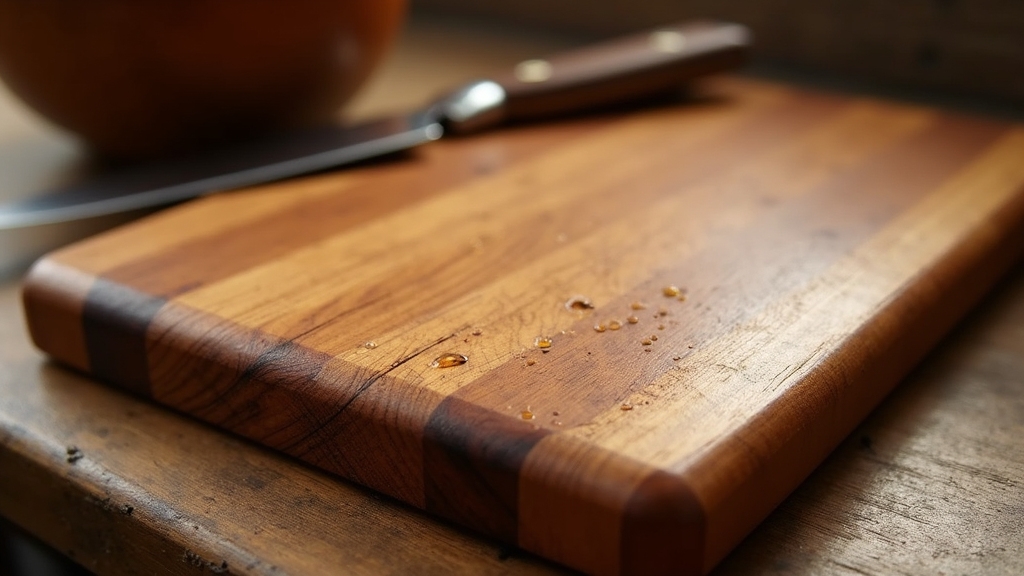
Although many hardwoods offer durability, teak wood stands out for cutting boards due to its balanced hardness and natural resistance to wear. You’ll find teak classified as a medium-hardwood, which means it withstands sharp knife impacts without significant surface damage or loss of structural integrity.
Its natural oils provide high water resistance, preventing warping and cracking. Unlike maple or walnut, teak resists warping, cracking, and splitting more effectively, maintaining its shape and functionality over time. Its dense, tough structure endures daily use with minimal degradation, ensuring longevity that can span decades if you maintain it properly.
Regular oiling and cleaning help preserve teak’s resilience. Additionally, periodic sanding restores the surface, removing deep knife marks and maintaining a near-new cutting surface, making teak an ideal choice for long-lasting cutting boards. To maximize durability, it is important to keep the wood properly conditioned to prevent drying and splitting over time.
Water and Moisture Resistance Benefits
When you choose teak wood for cutting boards, you benefit from its exceptional natural oil content, which creates a water-repellent barrier on the surface. These oils prevent water from penetrating the wood fibers, significantly reducing risks of warping, cracking, and rotting.
Its dense grain and natural oils contribute to its superior moisture resistance. Teak’s tight, uniform grain structure further minimizes moisture absorption by limiting gaps where water can reside.
This combination enhances durability in wet kitchen environments far beyond woods like acacia, walnut, or maple. Regular maintenance, including oil application, helps preserve these natural protective qualities over time.
Additionally, the oil content inhibits bacterial, mold, and mildew growth by restricting moisture uptake, improving hygiene. While teak resists water naturally, prompt drying and occasional oiling help maintain its protective properties.
Knife-Friendliness and Surface Hardness
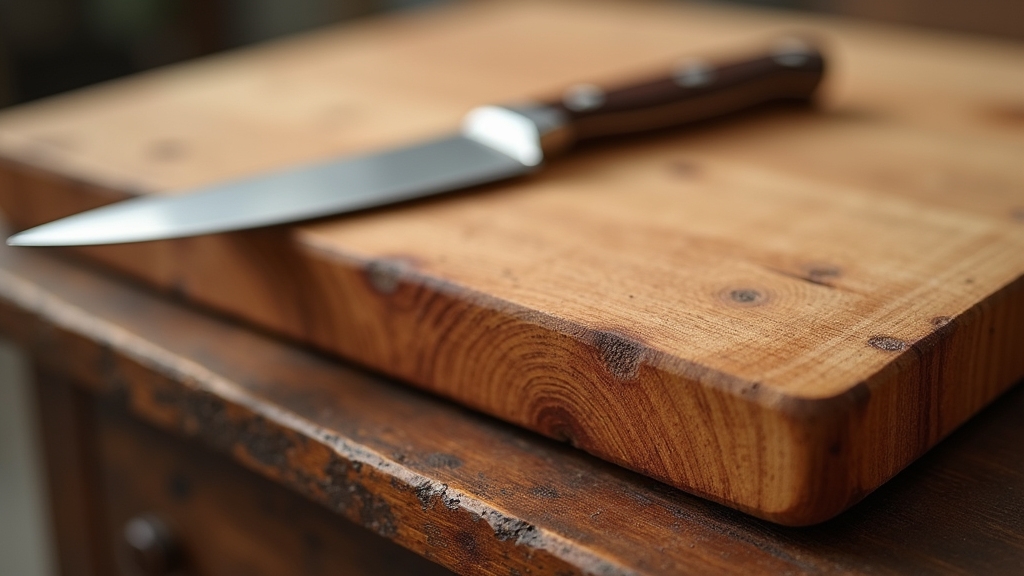
Since knife performance heavily depends on the cutting surface, choosing teak wood for your cutting board strikes an ideal balance between durability and blade preservation.
Teak’s smooth, uniform grain and natural oils create a surface that’s gentle on blades, reducing dulling compared to harder woods.
Edge grain boards offer a softer, precise cutting experience, while end grain teak enhances durability and knife edge protection through vertical fiber alignment.
Teak’s medium-high hardness withstands daily use without warping or cracking, maintaining stability over time. Its natural density also contributes to its resistance against scratches and impact.
Its balanced density minimizes knife wear while resisting deep cuts and gouges.
Additionally, teak’s natural oils provide moisture resistance that helps prevent rot and decay, extending the board’s lifespan.
This combination means your knives stay sharper longer, requiring less frequent sharpening, and your cutting board remains resilient, providing a consistent, knife-friendly surface for extended use.
Natural Antibacterial and Health Properties
You’ll appreciate that teak wood naturally inhibits bacterial growth due to its antimicrobial oils and resins. This makes it a food-safe material that actively reduces contamination risks during food preparation. Its inherent antibacterial qualities come from specific natural oils that create an environment unsuitable for bacterial survival.
Choosing teak cutting boards supports both hygiene and health without relying on synthetic additives. Additionally, proper care such as cleaning and drying techniques helps maintain the board’s natural resistance to bacteria and prevents issues like rust on knives used with it.
Antibacterial Effects of Teak
Although many wood types offer some antimicrobial benefits, teak wood stands out due to its unique combination of natural oils, tannins, and resins that actively inhibit bacterial growth on cutting surfaces.
These compounds disrupt microbial proliferation, maintaining hygiene even after repeated use. Its natural chemical composition works similarly to how stainless steel peelers resist bacterial buildup through self-cleaning properties.
Teak’s porous yet dense structure traps bacteria, limiting survival and preventing contamination. Additionally, teak is known for its natural water resistance, which prevents moisture from penetrating the wood and creating an environment conducive to bacterial growth.
When you choose teak for cutting boards, you gain:
- Sustained 99.9% antimicrobial activity, surpassing many materials
- Resistance to moisture retention, reducing bacterial growth conditions
- Dimensional stability and hardness that minimize bacterial colonization sites
- Hypoallergenic and non-toxic properties ensuring safe food contact
Food-Safe Wood Benefits
When selecting a cutting board, you benefit from teak wood’s natural composition that enhances food safety through inherent oils and moisture resistance. These oils repel water, minimizing moisture absorption, mold growth, and cracking, which prolongs the board’s lifespan.
This water repellency limits bacterial proliferation by reducing surface moisture, making teak more hygienic than many alternatives. Additionally, teak’s durability and resistance to warping ensure stable, safe food contact. Bamboo cutting boards, for example, are known for their natural antimicrobial properties that also contribute to hygiene.
Porous materials like wood, bamboo, and paper composites are preferable for sustainability and function, sourced from natural origins.
Teak cutting boards employ food-safe mineral oils and beeswax finishes, avoiding harmful synthetic coatings. You’ll also appreciate that responsibly sourced teak complies with FDA food contact standards and uses formaldehyde- and VOC-free adhesives.
Environmental and Sustainability Considerations
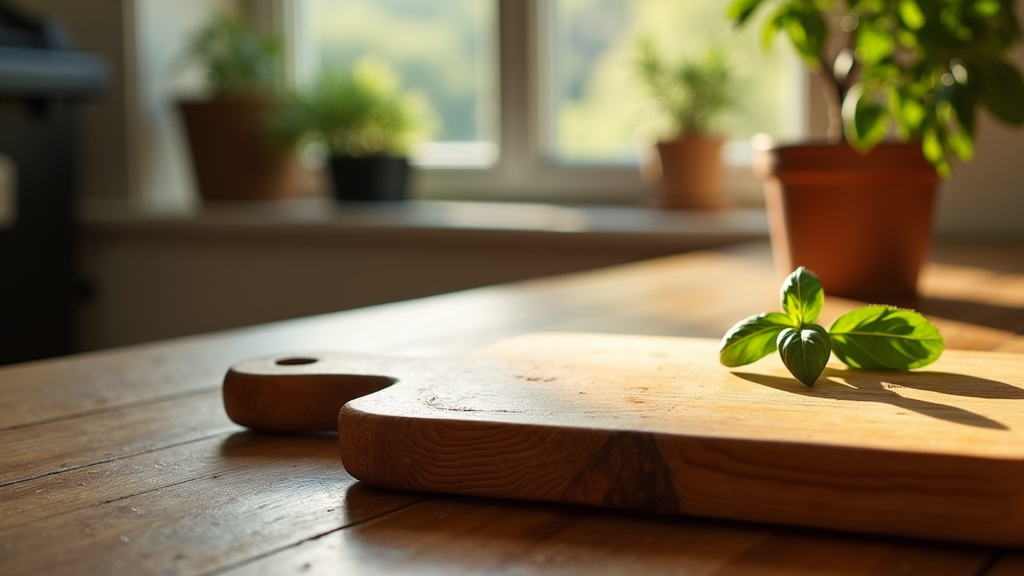
You should prioritize teak cutting boards sourced from FSC-certified plantations to guarantee sustainable harvesting and reduce illegal logging impacts. Choosing teak means investing in a durable product that resists warping and decay, lowering the need for frequent replacement.
This longevity, combined with eco-conscious production, makes teak an environmentally responsible choice for your kitchen.
Additionally, teak cutting boards made from FSC®-certified sustainable teakwood ensure eco-friendly production and support forest conservation efforts. Selecting products that are easy to clean and maintain also contributes to their sustainability by extending their usable life.
Sustainable Teak Sourcing
Because sustainable teak sourcing directly influences environmental health and resource longevity, understanding its principles is essential for anyone involved in timber selection or forestry management.
You should prioritize plantation teak, which prevents deforestation of natural forests and supports reforestation through regulated harvesting cycles. Plantation teak is a sustainable choice grown specifically on managed plantations that ensures forests can thrive while providing high-quality timber.
Plantation teak also addresses concerns related to the slow growth rate of natural teak trees, helping meet demand without overexploiting wild forests.
Avoid contributing to illegal logging that depletes wild teak populations and harms biodiversity. Certifications like FSC and FLEGT verify legal and sustainable origins, ensuring transparency and accountability.
Key factors in sustainable teak sourcing include:
- Managed plantations that promote renewable timber production without ecological degradation
- Certification programs enforcing legality and environmental standards
- Avoidance of illegal logging to protect habitats and biodiversity
- Integration of teak plantations with agroforestry systems to enhance carbon sequestration and ecosystem health
Teak’s Longevity Benefits
Although selecting cutting board materials often centers on immediate usability, considering teak’s longevity reveals significant environmental and sustainability advantages.
Teak’s natural hardness, density, and high oil content ensure resistance to warping, cracking, and moisture absorption, enabling it to maintain structural integrity over decades with proper care.
Routine maintenance such as washing with soapy water, rinsing thoroughly, and air drying after use helps preserve these qualities effectively. Its low porosity contributes to moisture resistance, making it less prone to bacterial growth and staining.
Its inherent antibacterial properties reduce microbial growth without chemical treatments, preserving hygiene and surface quality. Compared to hardwoods like maple or walnut, teak requires less frequent maintenance and replacement, decreasing resource consumption and environmental waste.
Routine cleaning combined with occasional mineral oil application sustains its durability and moisture defense.
Eco-Friendly Kitchen Choice
When selecting teak cutting boards, considering environmental and sustainability factors is crucial to making an eco-friendly kitchen choice. You want to guarantee your purchase supports responsible forestry and minimizes ecological damage. Choosing wood from sources that practice sustainable harvesting helps preserve natural habitats and biodiversity.
Key considerations include:
- Opt for teak certified by organizations like FSC or Rainforest Alliance to confirm sustainable sourcing and reduce illegal logging impacts.
- Account for carbon emissions linked to international transport; prioritize boards from well-managed plantations or local alternatives when possible.
- Choose teak boards free from plastic coatings or synthetic preservatives to avoid introducing petroleum-derived toxins into your kitchen.
- Leverage teak’s natural durability and water resistance to extend product lifespan, thereby lowering resource extraction and waste over time.
However, it is important to note that teak is sourced from endangered rainforests in Southeast Asia, which raises significant environmental concerns.
Maintenance and Care for Teak Cutting Boards
Proper maintenance and care are essential to preserve the durability and appearance of your teak cutting board. Wash it promptly with warm soapy water, rinse thoroughly, and air dry completely. Avoid soaking the board in water to prevent warping or damage.
Apply food-grade mineral oil regularly, ideally twice a month, to maintain moisture barriers and prevent cracking. Avoid soaking or harsh chemicals, and treat stains with baking soda or lemon and salt.
Sand worn areas when necessary, then re-oil.
Comparison of Teak to Other Common Woods
Since choosing the right wood impacts both performance and longevity, comparing teak to other common hardwoods is essential for selecting an ideal cutting board.
Teak stands out for its natural oils, offering superior moisture resistance and durability without frequent maintenance. However, its higher silica content can dull knives faster than softer woods like maple or beech.
Here’s how teak measures up:
- Durability: Teak resists cracking and warping better than acacia and walnut, but maple and beech resist scratches more effectively.
- Water Resistance: Teak’s natural oils outperform walnut and acacia, though maple and cypress have tighter grains reducing porosity further.
- Knife Friendliness: Maple and beech are gentler on blades; teak’s hardness causes more dulling. Additionally, acacia’s high grain density can also damage knife sharpness.
- Aesthetic: Teak’s warm golden-brown tones and uniform grain contrast with walnut’s dark elegance and acacia’s varied knots.
Common Uses of Teak in Kitchenware
Although teak wood demands a higher initial investment, you’ll find it excels in crafting kitchenware that withstands moisture, heat, and wear. Teak’s dense hardwood structure resists warping and cracking, making it ideal for cutting boards, spatulas, spoons, and salad tongs.
Its natural oils provide water resistance and antimicrobial properties, reducing bacterial growth and preventing odor absorption, which guarantees hygienic use.
You can confidently use teak utensils near boiling liquids or heated surfaces without worrying about damage or heat transfer, thanks to its heat-buffering oils. The smooth finish and ergonomic design of teak utensils also ensure a comfortable grip during cooking tasks.
Additionally, teak bowls and serving trays maintain durability while adding aesthetic value with their rich golden hues and unique grain patterns. Many artisanal teak pieces receive food-safe oil finishes, enhancing longevity and food safety for everyday kitchen tasks.
Tips for Maximizing the Lifespan of Teak Cutting Boards
To keep your teak cutting board performing at its best, attentive care is necessary to maintain its moisture balance and structural integrity. You should clean it promptly with warm soapy water, avoiding harsh abrasives, and dry thoroughly to prevent warping.
Regularly apply food-grade mineral oil or coconut oil to replenish moisture and protect the wood. It is important to season all sides of the board thoroughly when oiling to ensure even protection. Inspect for cracks and sand lightly to remove superficial damage without compromising thickness.
Follow these essential tips:
- Clean both sides after use and air dry completely before storage.
- Oil the board monthly or when it appears dry, using a soft cloth.
- Store in a dry, ventilated area away from direct sunlight or heat.
- Avoid soaking, dishwashers, and cutting with serrated or stabbing motions.
Frequently Asked Questions
Can Teak Cutting Boards Be Used for Both Raw Meat and Vegetables?
Yes, you can use teak cutting boards for both raw meat and vegetables, but you must clean them thoroughly between uses to prevent cross-contamination.
Teak’s natural oils inhibit bacterial growth, enhancing safety, yet they don’t eliminate all risks.
Wash with hot, soapy water and air dry after cutting raw meat.
Consider using separate boards or rigorous cleaning routines to maintain hygiene and extend your board’s lifespan effectively.
How Heavy Are Teak Cutting Boards Compared to Other Wood Boards?
Teak cutting boards are generally heavier than many other wood boards due to their dense grain and high natural oil content.
For example, a large teak board can weigh around 14 to 15 lbs, whereas bamboo or maple boards of similar size usually weigh less.
This extra weight provides stability during use but makes them less portable.
The dense, oily structure of teak increases overall mass compared to softer or less oily hardwoods.
Are Teak Boards Dishwasher Safe?
Imagine your teak cutting board cracking and warping like dried earth under a scorching sun. That’s what dishwashers do. You shouldn’t put teak boards in the dishwasher; heat and moisture rapidly dry and swell the wood, causing splits and damage.
Harsh detergents strip natural oils, accelerating deterioration. Instead, wash by hand with mild soap and warm water. Dry immediately and regularly oil to preserve its integrity and longevity.
Do Teak Cutting Boards Require Special Storage Conditions?
Yes, teak cutting boards require special storage conditions. You should store them in a cool, dry place away from direct sunlight and heat to prevent warping or cracking.
Avoid stacking heavy items on them, and never store them while damp to prevent bacterial growth.
Guarantee good air circulation for thorough drying after use. Maintaining controlled humidity and temperature helps preserve teak’s dimensional stability and prolongs your board’s lifespan.
Can Teak Wood Cutting Boards Be Personalized or Engraved?
Yes, you can personalize teak wood cutting boards through laser engraving. You’ll want to use settings around 475 speed, 65 power, and 340 LPI for ideal detail without damaging the wood.
Simple text, logos, or graphics work best, typically sized around 4″ x 4″.
After engraving, clean debris and apply a food-safe sealant to maintain hygiene and durability. This process lets you customize boards while preserving their functionality.
Upgrade Your Kitchen with Teak Wood Cutting Boards
Choosing teak wood for your cutting board is like selecting a shield that balances toughness with care. Its durability, water resistance, and natural antibacterial properties make it an excellent, long-lasting choice.
While gentle on knives, teak also demands proper maintenance to preserve its quality. Compared to other woods, it stands out for both performance and sustainability, ensuring your kitchen tool remains reliable and eco-conscious over time.

